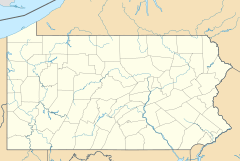Heilwood, Pennsylvania facts for kids
Quick facts for kids
Heilwood, Pennsylvania
|
|
|---|---|
| Country | United States |
| State | Pennsylvania |
| County | Indiana |
| Township | Pine |
| Area | |
| • Total | 1.25 sq mi (3.25 km2) |
| • Land | 1.25 sq mi (3.25 km2) |
| • Water | 0.00 sq mi (0.00 km2) |
| Population
(2020)
|
|
| • Total | 318 |
| • Density | 253.39/sq mi (97.81/km2) |
| Time zone | UTC-5 (Eastern (EST)) |
| • Summer (DST) | UTC-4 (EDT) |
| FIPS code | 42-33672 |
Heilwood is a small community in Indiana County, Pennsylvania, United States. It's called a census-designated place (CDP) because it's a specific area identified by the census bureau. In 2010, about 711 people lived there. By 2020, the population was 318.
Contents
Heilwood's Early History
From Logging to Coal Mining
In 1850, a part of Wheatfield Township in Indiana County became Pine Township. It was named for its many pine forests. In the 1880s, J.M. Guthrie started a logging settlement here. It had five houses, a store, stables, and a blacksmith shop. People started calling the area "Possum Glory" because there were so many possums around!
By 1894, the logging business wasn't doing well. Guthrie's land was sold in 1896 to J.M. Stewart. Stewart knew the land had lots of coal. Four years later, he sold it to John Heisley Weaver from Philadelphia. Weaver was a big industrialist who founded J.H. Weaver & Company.
Building a Model Town
John H. Weaver bought a lot of land in the area. By 1904, he decided to build a "model town" to support his growing coal mines. He named it "Heilwood." The name likely came from his nickname, "Heil," and his first coal mine, "Heisleywood."
A model town was a modern community built from scratch by a company. It had everything people needed, like a school, church, hotel, hospital, and a company store. The idea was that the town would only exist as long as the mine was active. The company paid for building the town and even acted like a local government. They kept public areas nice and paid some school officials.
Miners and their families rented houses from the company. This meant the company had a lot of control over their lives. For example, immigrant families often got small, uninsulated homes. If a miner lost his job or died, his family had only a few days to leave their home.
Still, many people preferred living in a model town. It offered steady work and a stable community. By 1905, 494 men worked in five mine complexes. They produced about 100,000 tons of coal each year.
Growth and Changes
In 1906, the Penn Mary Coal Company bought John H. Weaver's coal businesses for $1.8 million. They hired Harry P. Dowler as the new General Superintendent. Dowler worked hard to expand the mines. Over the next four years, he opened four new mines. He also brought in new ideas, like first aid training for miners.
In 1909, Heilwood reached its highest coal production: 888,058 tons! By 1911, 900 men worked in the mines. Dowler also kept building up the town. He oversaw the construction of a new school, company offices, a Catholic church, and more homes for miners and supervisors. By 1913, Heilwood was mostly complete.
New Owners and Unionization
The Penn Mary Coal Company was bought by the Cambria Steel Company in 1914. Then, in 1916, the Bethlehem Steel Company took over. Thomas Richards Johns became the new Superintendent. Bethlehem Steel invested over $500,000 to improve the Heilwood mines. They opened mines #9 and #11, which operated for many years.
Even with new owners, the mines were called Penn Mary until 1921. After that, they became known as Bethlehem Mines. In 1936, Heilwood got its first and only miners' union. This happened because new laws during the Great Depression supported workers' rights. Before this, companies often stopped unions from forming.
The Mines Close
In 1936, the Bethlehem Mines Corporation changed its name to Industrial Collieries Corporation. In 1940, the Redlands Coal Company, which was part of the original J.H. Weaver Company, leased the mines. This company eventually bought the mines in 1943.
Around this time, another company, Monroe Coal Company, started selling the houses and lots in Heilwood to the residents. Mining was no longer profitable enough for the company to keep running a private town.
The Redlands Coal Company ran the mines until 1948. Then, they sold them back to Bethlehem Steel. After one year, Bethlehem Steel sold them to the Pine Township Coal Company. This company operated until 1959, when the last mine, #11, ran out of coal and closed forever.
After the mines closed, Heilwood became much smaller. Most residents moved to nearby cities. It's amazing that a town built to be temporary lasted so long! You can learn more about Heilwood's history online at www.heilwood.com and at local historical societies.
Heilwood's Geography
Heilwood is located at 40°38′14″N 78°52′57″W / 40.63722°N 78.88250°W. It covers an area of about 3.25 square kilometers (1.25 square miles), and all of it is land.
Heilwood's Population
| Historical population | |||
|---|---|---|---|
| Census | Pop. | %± | |
| 2020 | 318 | — | |
| U.S. Decennial Census | |||
In 2000, there were 786 people living in Heilwood. There were 304 households, and 221 of them were families. Most people were White (99.49%).
About 24.8% of the population was under 18 years old. About 18.1% were 65 or older. The average age was 39 years. The median income for a household was $29,722.
Notable Person from Heilwood
- Augie Donatelli, a famous MLB umpire.
See also
 In Spanish: Heilwood para niños
In Spanish: Heilwood para niños



